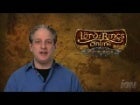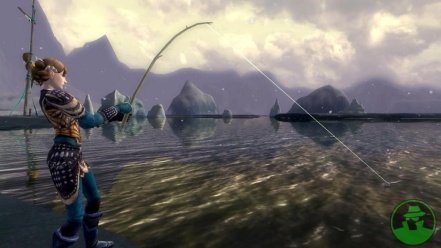A few lines in one of the appendices to J.R.R. Tolkien's "The Lord of the Rings." That's all the reference Turbine had when it came to the latest content addition for its Tolkien-themed MMO The Lord of the Rings Online. According to Tolkien's writings on the ancestors of the Dunedain (Aragorn's people), the "Snow-men of Forochel" are mentioned as aiding Arvedui, the last King of Arthedain, the kingdom whose fall doomed his people to become the more familiar wandering Rangers. We recently got a chance to wander the frozen lands of Forochel and sample a whole world of ice-themed content that LotRO players will get to sample in Book 13: Doom of the Last-king.
Northern Lights
The first thing we saw when we logged in for our tour of Forochel was the ghost of a noble-looking Man floating in the beached wreckage of an elf-ship. This, we were told, was the spirit of Arvedui, the titular Last-king. He was haunting the site of his demise, a shipwreck caused in an unnatural storm sparked by the Witch-king of Angmar. The storyline of Forochel's 100+ new quests will follow Arvedui's story as he attempts to help the Lossoth, the descendents of the "Snow-men" who aided him fight a brand-new plot against the region by their unholy neighbor to the east. According to producer Aaron Campbell and executive producer Jeffrey Steefel, though, there's much more to Forochel than just ice and snow-themed quest content. The new book will introduce new game mechanics the team hopes will not only enhance the current gameplay experience, but also act as a test-bed for content in the Mines of Moria.
"Check out that roof!" Steefel says as we begin our tour by running through an underground highway that acts as the entrance to Forochel. What he was referring to was the sheer size of the underground space. Book 13 will introduce a number of new graphic tricks that vastly increase the size and variety of underground spaces the developers can create. In this case what we were looking at was a sheer expanse of ice-covered wall that looked as though it had been carved by running water. The ceiling was so high it could barely be seen through the lighting effects, giving the impression of misty air lit by the refraction of water droplets. "This is kind of a test for some of the things we want to do in Mines of Moria," Steefel said. "We wanted to be able to create interesting underground spaces with broad avenues and multi-level 'terrain' that's different than anything anyone's seen before."
As we headed toward the exit, we took a quick detour into a small cave that was filled with sparkling lights. Rather than give us any warning, the two producers instead let us be surprised by a swirling column of air, twinkling lights and flying ice chips. "Those are the Grims," Campbell said. The Grims are one of several new monster types being introduced in Book 13 including saber-toothed tigers, moose, wolverines and new varieties of Gauredain and cold-themed versions of wargs and wyrms. What's interesting about the Grims is they mark the result of a challenge the dev team set for themselves -- could they develop a convincing monster made up almost entirely of graphic effects? The resulting Grims have almost no 3D components save the ice chips, all impression of space and volume has been generated by colored lights and swirling air effects.
Global Cooling
Exiting the cavern, we came upon Forochel proper and what greeted us was a beautifully realized world of ice and snow. According to Steefel and Campbell, because of the paucity of actual Tolkien reference material, the team instead tried to think about what Tolkien might have done had he set a full story in this region. If Middle-earth in general was the professor's modern take on classic Anglo-Saxon/European mythology, it only makes sense that the cold Northern region of Middle-earth would be based on Northern European cultures. Thus the buildings and culture of the native Lossoth (a new player-reputation faction for the region) are an amalgam of Lapp, Swedish, Finnish and Norwegian influences, with large buildings made of tanned leather hides stretched between wood cut from fir trees.






